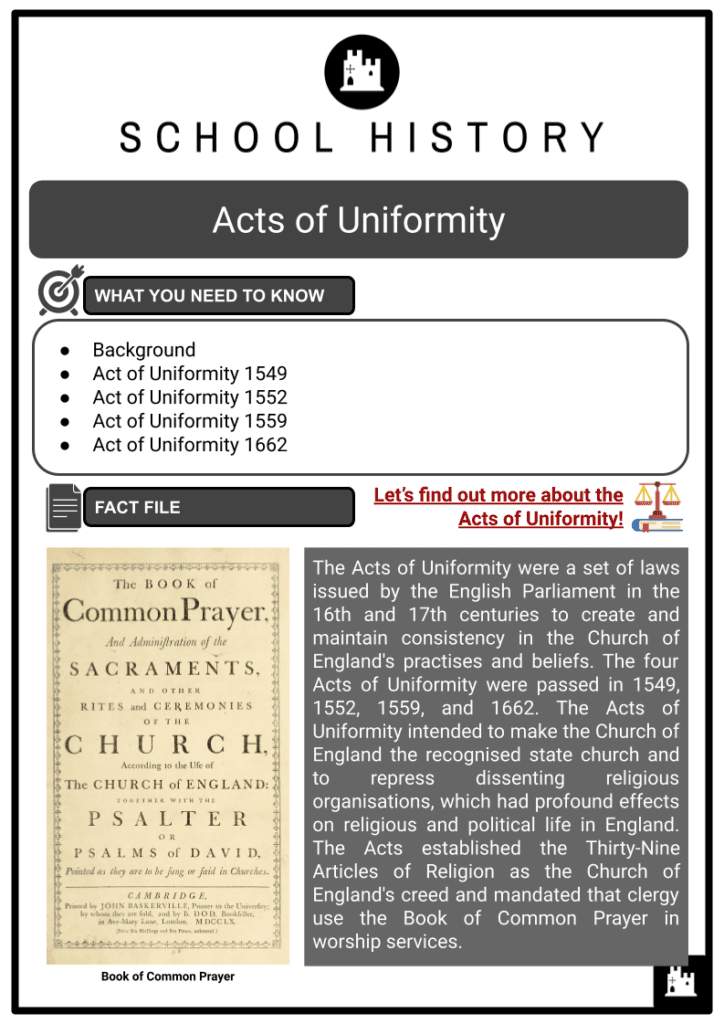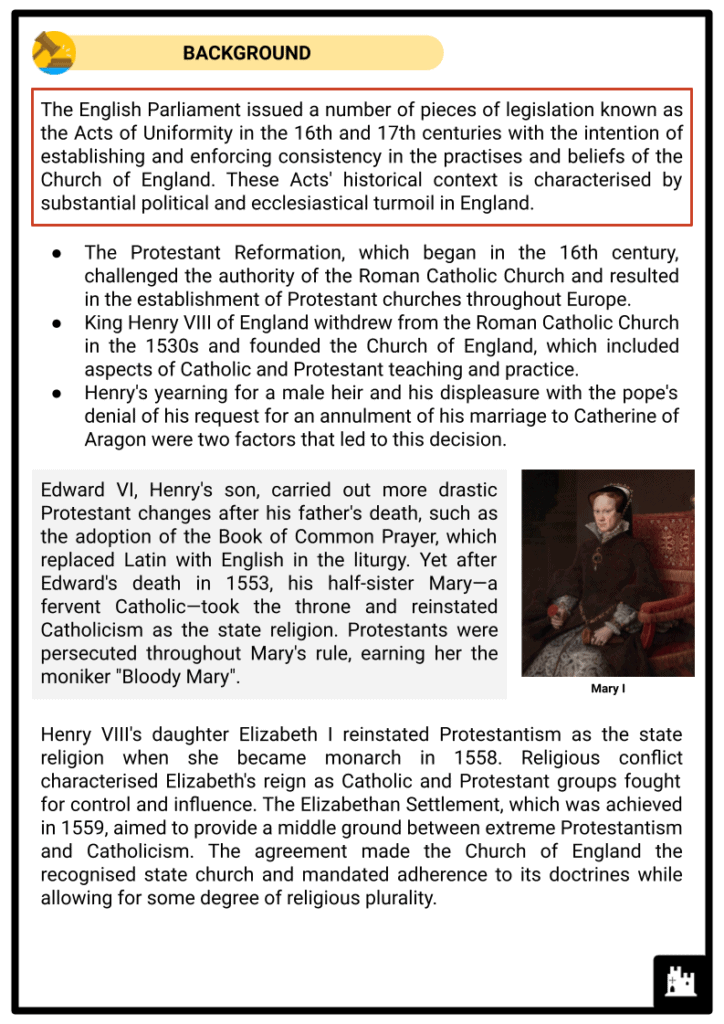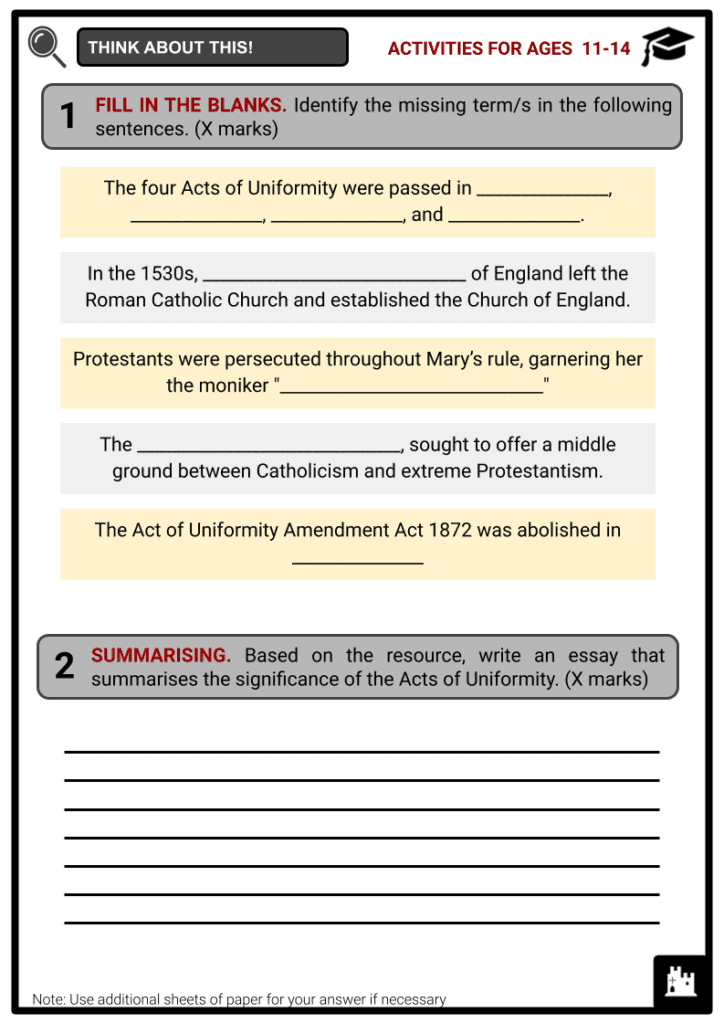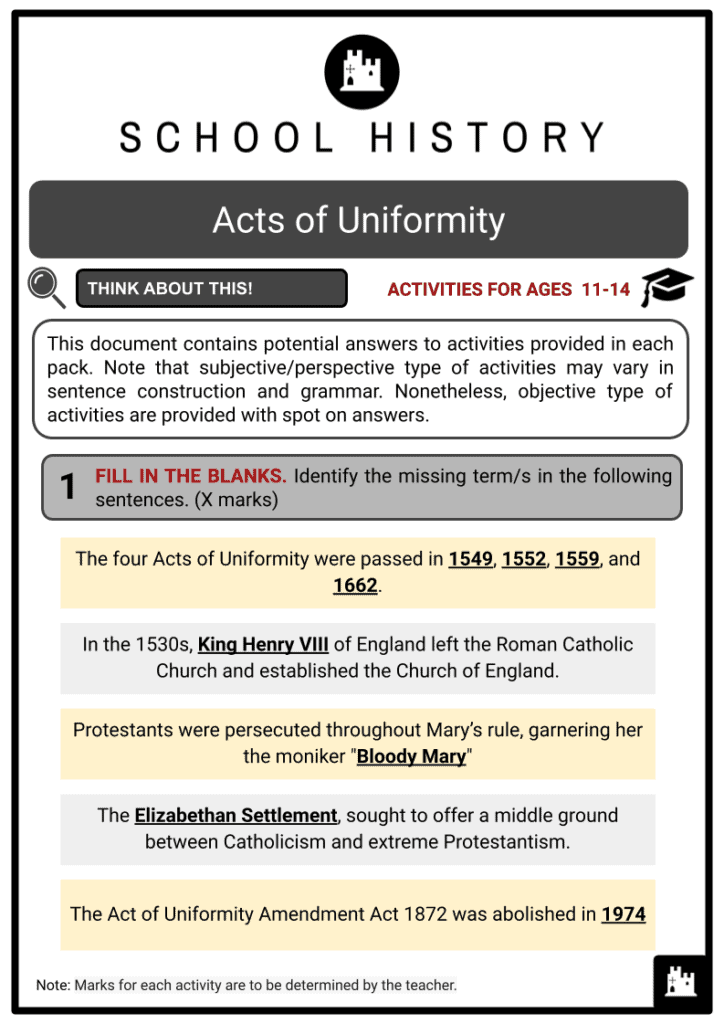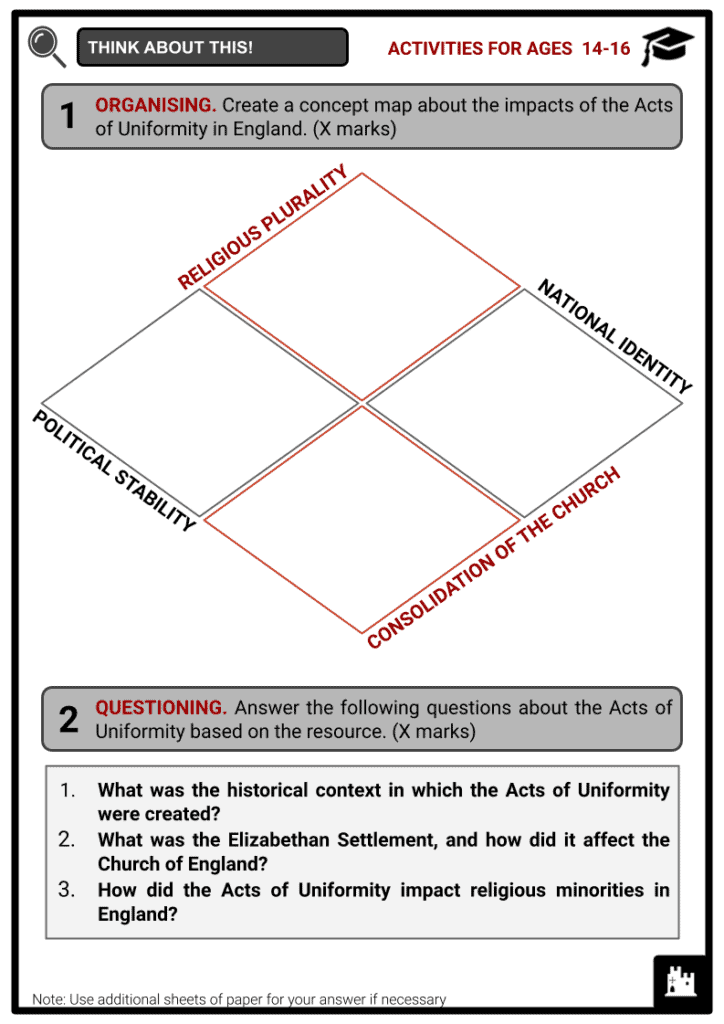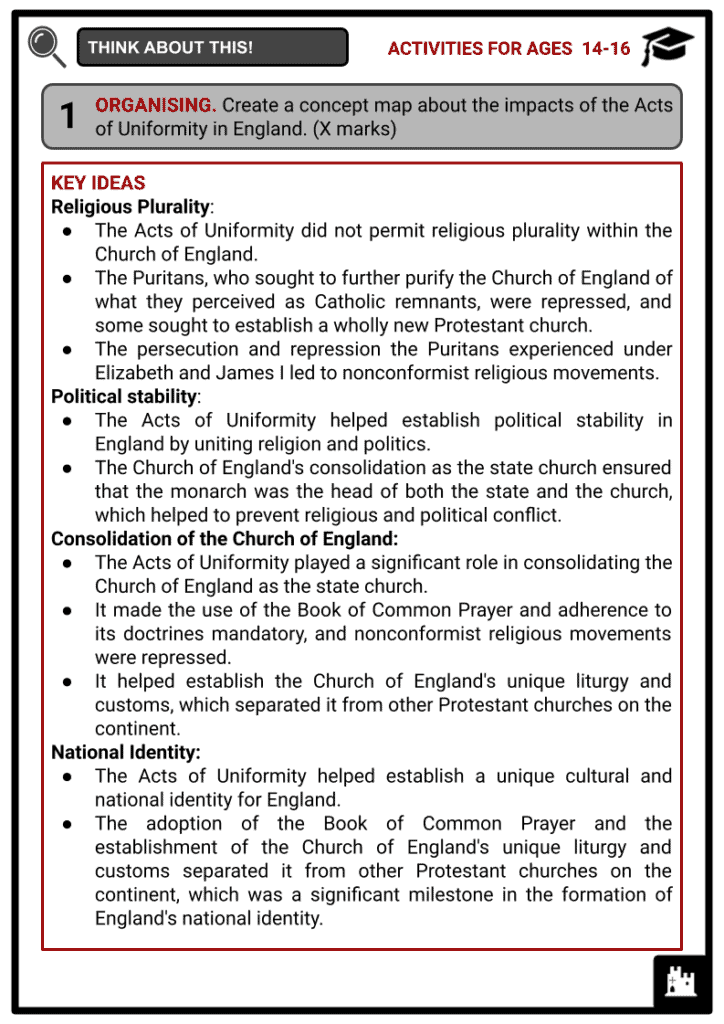Acts of Uniformity Worksheets
Do you want to save dozens of hours in time? Get your evenings and weekends back? Be able to teach about the Acts of Uniformity to your students?
Our worksheet bundle includes a fact file and printable worksheets and student activities. Perfect for both the classroom and homeschooling!
Summary
- Background
- Act of Uniformity 1549
- Act of Uniformity 1552
- Act of Uniformity 1559
- Act of Uniformity 1662
Key Facts And Information
Let’s find out more about the Acts of Uniformity!
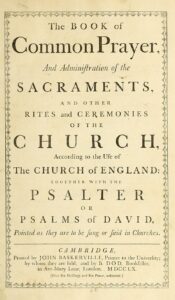
The Acts of Uniformity were a set of laws issued by the English Parliament in the 16th and 17th centuries to create and maintain consistency in the Church of England's practises and beliefs. The four Acts of Uniformity were passed in 1549, 1552, 1559, and 1662. The Acts of Uniformity intended to make the Church of England the recognised state church and to repress dissenting religious organisations, which had profound effects on religious and political life in England. The Acts established the Thirty-Nine Articles of Religion as the Church of England's creed and mandated that clergy use the Book of Common Prayer in worship services.
BACKGROUND
- The English Parliament issued a number of pieces of legislation known as the Acts of Uniformity in the 16th and 17th centuries with the intention of establishing and enforcing consistency in the practises and beliefs of the Church of England. These Acts' historical context is characterised by substantial political and ecclesiastical turmoil in England.
- The Protestant Reformation, which began in the 16th century, challenged the authority of the Roman Catholic Church and resulted in the establishment of Protestant churches throughout Europe.
- King Henry VIII of England withdrew from the Roman Catholic Church in the 1530s and founded the Church of England, which included aspects of Catholic and Protestant teaching and practice.
- Henry's yearning for a male heir and his displeasure with the pope's denial of his request for an annulment of his marriage to Catherine of Aragon were two factors that led to this decision.
- Edward VI, Henry's son, carried out more drastic Protestant changes after his father's death, such as the adoption of the Book of Common Prayer, which replaced Latin with English in the liturgy. Yet after Edward's death in 1553, his half-sister Mary—a fervent Catholic—took the throne and reinstated Catholicism as the state religion. Protestants were persecuted throughout Mary's rule, earning her the moniker "Bloody Mary".
- Henry VIII's daughter Elizabeth I reinstated Protestantism as the state religion when she became monarch in 1558. Religious conflict characterised Elizabeth's reign as Catholic and Protestant groups fought for control and influence. The Elizabethan Settlement, which was achieved in 1559, aimed to provide a middle ground between extreme Protestantism and Catholicism. The agreement made the Church of England the recognised state church and mandated adherence to its doctrines while allowing for some degree of religious plurality.
- Religious strife persisted despite the Elizabethan Settlement, and nonconformist religious movements like the Puritans were born. Some Puritans called for the founding of a wholly new Protestant church while others tried to further "purify" the Church of England of what they perceived as Catholic remnants. The Acts of Uniformity were created in an effort to promote and enforce conformity to the customs and beliefs of the Church of England because of the persecution and repression the Puritans experienced under Elizabeth and her successor, James I.
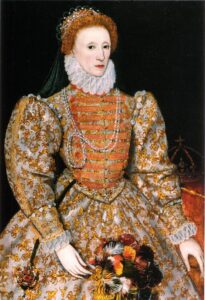
Queen Elizabeth I - The Book of Common Prayer was mandated to be used in all public worship services by the first Act of Uniformity, which was passed in 1549 under the reign of Edward VI. The Latin Mass was likewise abolished by this edict, and an English liturgy took its place. Nevertheless, Mary I repealed this law in 1553 and reinstated Catholicism as the state religion.
ACT OF UNIFORMITY 1549
- The Act of Uniformity 1549 was a law enacted by the English Parliament on 21 January 1549. It was the natural follow-up to the Edwardian Injunctions of 1547 and the Sacrament Act of that year, which had taken sporadic moves towards the formal adoption of Protestant theology and practise throughout England and Wales. It made the Book of Common Prayer from 1549 the only authorised method of worship in England. The English churches utilised various iterations of the Latin-language Missal prior to 1549.
- The Act of Uniformity 1549 was part of the English government's larger endeavour to reform the Church of England and develop a distinctively Protestant character. It came after the Book of Common Prayer's debut in 1548, which saw the old Latin Mass supplanted with a fresh English-language liturgy. In addition to requiring clergy to wear a surplice and apply the sign of the cross at baptism, the Act also made the use of the new prayer book a requirement for all churches in England.
- The Act was controversial, particularly among those who preferred a more Catholic-inspired form of worship. The old Latin Mass was still being used by many individuals, particularly in the north of England, who refused to accept the new prayer book. As a result, there were numerous demonstrations, and in some places, even riots. The government reacted by enacting severe penalties, such as fines and jail for anyone who disobeyed.
- The Church of England's connection with the larger European Protestant movement was also significantly impacted. The Act essentially separated the English church from the Lutheran and Calvinist churches on the continent, each of which had its own unique liturgies, by requiring the use of the Book of Common Prayer. This transition to a uniquely English Protestantism was a significant milestone in the formation of England's national identity.
- Later Acts of Uniformity, most notably those from 1552 and 1662, updated and superseded the Act of Uniformity from 1549. These Acts established the Church of England's status as the state religion of England and further formalised the Church of England's particular liturgy and customs. The Act of Uniformity of 1549, however, continues to be a significant turning point in the growth of the Church of England and the history of the English Reformation.
ACT OF UNIFORMITY 1552
- The Act of Uniformity 1551, sometimes known as the Act of Uniformity 1552, was passed by Edward VI of England on 5 April 1552 as part of an effort to make England more Protestant before his death the following year. The Act of 1552 replaced the earlier Act of 1549 and replaced the 1549 Book of Common Prayer with a revised and more overtly Protestant edition. Anybody who participated in or oversaw a service that did not make use of the amended liturgy was subject to severe penalties under the statute.
- The Edwardian reformation combined conventional church and ministry organisation with moderately reformed theology. An appeal to the Early Church, which existed before Roman errors contaminated it, was used to support it. The ritual of 1549 impliedly abandoned transubstantiation, and in response to John Knox's vehement criticism in 1552, a justification of the kneeling requirement for communion was authorised through the "Black Rubric."
- The 1552 ordinal that had been included in the Book of Common Prayer was believed to have been approved under the Act of Uniformity 1559 before Elizabeth I's ascension to the throne. William Cecil, however, informed the queen that Thomas Cranmer's ordination ritual was forbidden since the deed did not include the ordinal.
- After Mary I repealed all of Edward VI's religious regulations, put prominent Protestant clerics in jail, and recognised her mother's union to Henry VIII as valid, her husband Philip II of Spain persuaded Parliament to overturn all of Henry VIII's religious regulations, handing back control of England to the Roman Catholic Church. With the passage of a new Act of Uniformity in 1559, which removed Mary I's heresy prohibitions and made penalties for breaking the Act less harsh, the Church of England began using the 1552 Book of Common Prayer with certain pre-Reformation alterations upon Elizabeth's arrival to the throne.
The following were the repealed provisions:
- The mandate that everyone attend the Church of England and Ireland on Sundays and holy days, or face punishment from the church's censures if they choose to attend another place of worship in place of the established church.
- For anyone who willingly participates in any other form of Common Prayer or sacrament than what is described in the Book of Common Prayer, there is a penalty of imprisonment for six months without bail or main prize for the first offence, one year for the second offence, and life in prison for the third offence.
- The mandate that all curates recite the Act of Uniformity 1552 in church on one Sunday every three months, for a year following the Feast of All Saints, and explain to the congregation how God's compassion and goodness had been manifested to his people through prayer.
- Any Act or Acts of the Irish Parliament that applied the Act of Uniformity's 1552 provisions to Ireland.
ACT OF UNIFORMITY 1559
- The Act of Uniformity 1559 was a law enacted by the English Parliament 28 April 1559 to standardise sacrament administration, prayer, and other aspects of divine worship in the Church of England. The Elizabethan Religious Settlement in England, which Elizabeth I established in an effort to reunite the church, included the Act. The Act of Supremacy 1558 and the Thirty-Nine Articles were two further Acts that were relevant to this settlement.
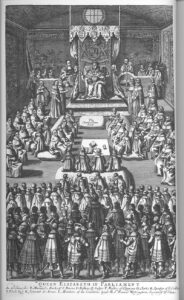
Elizabeth I in the Opening of Parliament - The Book of Common Prayer, which had been updated since the Act of Uniformity 1552, was to be used for all public worship services in the Church of England as of the Act of Uniformity 1559. This provided a uniform style of worship across the nation, with prayers and liturgy that were identifiable to all churchgoers. All ministers were obligated to use the Book of Common Prayer and adhere to the Archbishop of Canterbury's rules and regulations. Using any other style of worship or departing from the established sequence of service was deemed a crime.
- All clergy and church officials were compelled under the Act to swear an oath of loyalty to the Queen as the head of the church. This highlighted the tight ties between the Church of England and the monarchy and served as a representation of the monarch's control over the church.
- Also, it mandated the wearing of specific veils, such as the surplice, during church services. These garments were meant to separate clergy from laypeople and were viewed as representations of the power of the church.
- Last but not least, the Act of Uniformity 1559 imposed fines and jail time for anybody who disregarded its requirements. This was deemed vital to maintain the same standards of worship throughout the nation and to stop the emergence of dissident movements that may impugn the legitimacy of the official church.
ACT OF UNIFORMITY 1662
- The Act of Uniformity 1662 was an English act passed on 19 May 1662 that enforced adherence to the 1662 Book of Common Prayer for public worship, including sacraments and other rituals, and needed it in order to hold public office. Also, it reinstated the necessity for episcopal ordination for all clergy, which Puritans had removed during the Civil War, and demanded that the Bible be translated into British or Welsh.
- The form of public prayers, the delivery of sacraments, and other Church of England rituals were established by the Act in accordance with the rites and ceremonies outlined in the Book of Common Prayer of 1662. Every office in the government or the church required adherence to this. It was also necessary to translate the Book of Common Prayer into either British or Welsh. This made it possible for those whose primary language was not English to continue to partake in Church of England religious activities.
- The Act of Uniformity of 1662 resulted in the Great Ejection of over 2,000 pastors from the Church of England for refusing to take the oath.
- The Act of Uniformity Amendment Act of 1872 changed several clauses, including simplifying the statement required of clergy during their ordination and allowing for the nomination of more bishops to serve the expanding urban population.
- Over time, some requirements of the Act of Uniformity of 1662 were viewed as outdated or restrictive, leading to changes in the Church of England's practices.
- In 1980, the General Synod of the Church of England abolished the rule requiring clergy to use the Book of Common Prayer at every service, which had been enforced for over three centuries.
- Later, as part of broader changes aimed at modernising and broadening the Church, the General Synod of the Church of England abolished the Act of Uniformity Amendment Act 1872 in 1974. This choice was meant to reflect the evolving requirements and expectations of churchgoers in a more varied and secular society, and it was part of a larger movement towards greater tolerance and flexibility in religious practise.
Image Sources
- https://en.wikipedia.org/wiki/Book_of_Common_Prayer#/media/File:Book_of_Common_Prayer_1760.jpg
- https://en.wikipedia.org/wiki/Elizabethan_Religious_Settlement#/media/File:Darnley_stage_3.jpg
- https://en.wikipedia.org/wiki/Elizabethan_Religious_Settlement#/media/File:Queen_Elizabeth_opening_Parliament.jpg

